20 December 2023
COVID-19 studyWatching Videos about Illness Increases SARS-SoV-2-Specific Antibodies

Photo: Pixabay
Secretory immunoglobulin A (slgA) in our saliva is the most important antibody for fighting respiratory pathogens. It is formed by plasma cells and it binds antigens and prevents them from bonding to epithelial cells. In this way, slgA contributes significantly to our immunity. Earlier studies have already revealed a link in our saliva between a high concentration of the slgA specific to the coronavirus (SARS-CoV-2-specific slgA) and asymptomatic COVID-19 infections, indicating slgA’s protective role in fighting SARS-CoV-2.
In light of these functions, SARS-CoV-2-specific slgA might also have a neutralizing effect for SARS-CoV-2 in our bodies. Under the aegis of the Department of Biology at Universität Hamburg, researchers have now discovered that in the saliva of test subjects who watched a video about people with typical COVID-1 respiratory symptoms more spike protein-specific slgA appears shortly after viewing than in the saliva of those who watched a video about healthy people.
“The average secretion increased by 24.4 percent after 5 minutes of stimulation from the videos of illness,” says junior professor Dr. Esther Kristina Diekhof from the Department of Biology at Universität Hamburg and senior author of the study. “That there was this kind of increase even though there was no actual pathogen suggests that SARS-CoV-2-specific slgA could be part of a proactive immune reaction that prepares the inside of the mouth for penetration by viruses.” Shorty after the videos ended, the slgA value in saliva returned to its starting level.
The researchers also looked at the specific antibody (anti-RBD) against the receptor-binding domain (RBD) for SARS-CoV-2. The RBD enables the virus to penetrate cells and cause infection. In the present study, these antibodies did not reveal any change following stimulation from the videos.
The findings indicate that the antibodies have different functions: while the SARS-CoV-2-specific slgA presumably plays a general role in immune exclusion and is already released proactively when test subjects watch a video, the anti-RBD is presumably more likely involved in the actual neutralizing of the viruses and is only released after direct contact with pathogens. Prospective studies will focus more closely on this interpretation.
There were 45 test subjects between 18 and 35 (including 22 women) who had either been vaccinated or already had the coronavirus. Most of the tests took place between the first and second Omicron wave of the COVID-19 pandemic and thus in a high-risk context for catching SARS-CoV-2. Participants were shown a 5-minute video of people with the illness who had various typical COVID-19 respiratory symptoms (e.g., sneezing or coughing).
“We cannot unambiguously conclude from the present findings that the immunological response of the mucous membranes fundamentally go back to the video of respiratory illness and that in each and every situation the observed pattern of an increase in the SARS-CoV-2-specific slgA occurs,” says doctoral researcher Judith Keller, the study’s first author. Other viral pathogens of the respiratory system, such as influenza, have shown that a high-risk context (e.g., during the flu season) is linked to an increase in slgA while the same is not the case in a low-risk context (e.g., in summer months).
Original publication:
Keller, J.K., Dulovic, A., Gruber, J. et al. SARS-CoV-2 specific sIgA in saliva increases after disease-related video stimulation. Sci Rep 13, 22631 (2023). https://www.nature.com/articles/s41598-023-47798-y
